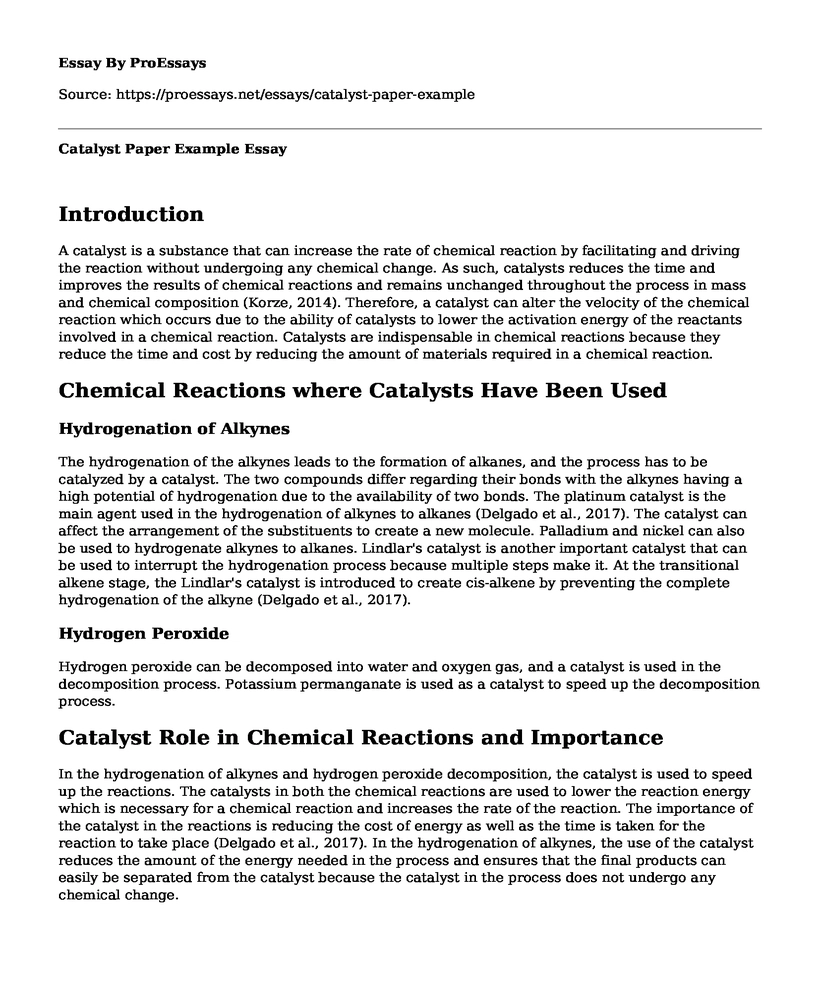Introduction
A catalyst is a substance that can increase the rate of chemical reaction by facilitating and driving the reaction without undergoing any chemical change. As such, catalysts reduces the time and improves the results of chemical reactions and remains unchanged throughout the process in mass and chemical composition (Korze, 2014). Therefore, a catalyst can alter the velocity of the chemical reaction which occurs due to the ability of catalysts to lower the activation energy of the reactants involved in a chemical reaction. Catalysts are indispensable in chemical reactions because they reduce the time and cost by reducing the amount of materials required in a chemical reaction.
Chemical Reactions where Catalysts Have Been Used
Hydrogenation of Alkynes
The hydrogenation of the alkynes leads to the formation of alkanes, and the process has to be catalyzed by a catalyst. The two compounds differ regarding their bonds with the alkynes having a high potential of hydrogenation due to the availability of two bonds. The platinum catalyst is the main agent used in the hydrogenation of alkynes to alkanes (Delgado et al., 2017). The catalyst can affect the arrangement of the substituents to create a new molecule. Palladium and nickel can also be used to hydrogenate alkynes to alkanes. Lindlar's catalyst is another important catalyst that can be used to interrupt the hydrogenation process because multiple steps make it. At the transitional alkene stage, the Lindlar's catalyst is introduced to create cis-alkene by preventing the complete hydrogenation of the alkyne (Delgado et al., 2017).
Hydrogen Peroxide
Hydrogen peroxide can be decomposed into water and oxygen gas, and a catalyst is used in the decomposition process. Potassium permanganate is used as a catalyst to speed up the decomposition process.
Catalyst Role in Chemical Reactions and Importance
In the hydrogenation of alkynes and hydrogen peroxide decomposition, the catalyst is used to speed up the reactions. The catalysts in both the chemical reactions are used to lower the reaction energy which is necessary for a chemical reaction and increases the rate of the reaction. The importance of the catalyst in the reactions is reducing the cost of energy as well as the time is taken for the reaction to take place (Delgado et al., 2017). In the hydrogenation of alkynes, the use of the catalyst reduces the amount of the energy needed in the process and ensures that the final products can easily be separated from the catalyst because the catalyst in the process does not undergo any chemical change.
End Products of Catalyst in a Chemical Reaction
In the hydrogenation of alkynes and decomposition of the hydrogen peroxide, the reaction does not result in changes in the catalysts and can easily be retrieved back and reused in future chemical reactions (Korze, 2014). This property of catalysts makes them special in every aspect and can be used in industries to speed up the reactions while saving up the energy required in the reaction.
Catalyst Role in Biochemical Reactions
A biochemical reaction involves the transformation of a molecule to a different molecule inside a cell, and catalysts called enzymes also mediate them. The biological catalysts in biochemical reactions can alter the specificity of the reaction as well as the rate at which the reaction takes place inside a cell. For instance, a catabolic reaction which is the breakdown of glucose to produce energy is a form of biochemical reaction. For example, in digestion, a catabolic enzyme is used to reduce food substrate into energy. In the case where the substrate is starch, amylase which is a biological catalyst breaks starch into maltose in the process producing energy (Milanowski, Carter, & Weber, 2013). Similarly, in biochemical reactions, catalysts increase the rate of reaction by reducing the energy requirements and also promotes the preservation of the reactants and the products equilibrium.
References
Delgado, J. A., Benkirane, O., Claver, C., Curulla-Ferre, D., & Godard, C. (2017). Advances in the preparation of highly selective nanocatalysts for the semi-hydrogenation of alkynes using colloidal approaches. Dalton Transactions, 46(37), 12381-12403.
Korze, D. (2014). Physical Properties Of A Catalyst Intermetallic Compound InPd.
Milanowski, P., Carter, T. J., & Weber, G. F. (2013). Enzyme catalysis and the outcome of biochemical reactions. Journal of Proteomics Bioinform, 6, 132-141.
Cite this page
Catalyst Paper Example. (2022, Jul 21). Retrieved from https://proessays.net/essays/catalyst-paper-example
If you are the original author of this essay and no longer wish to have it published on the ProEssays website, please click below to request its removal:
- Challenges Facing Dubai - Research Paper Summary
- Characteristics of Okanagan Valley Paper Example
- Essay Sample on Mercury Pollution: Human-Made & Natural Causes & Impacts
- Essay Example on Metaphysics: Exploring Abstract Objects & Phenomena
- Essay Sample on Math Education: Developing Procedural & Conceptual Understanding
- Paper Sample on UDL-Transform Math Course Syllabus for Student-Centered Learning
- Free Essay Sample on Exploring and Terraforming Mars: A Feasible Proposal for Human Colonization







